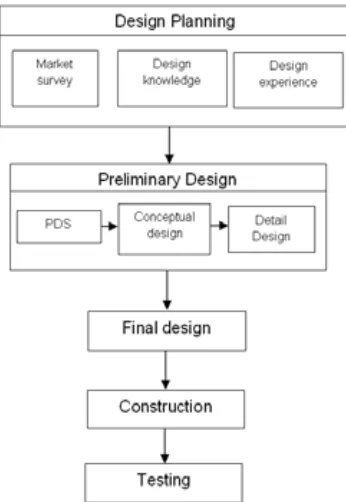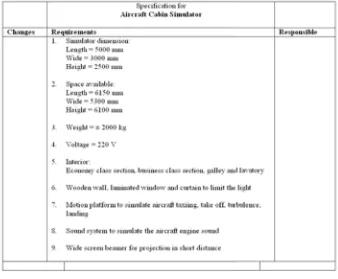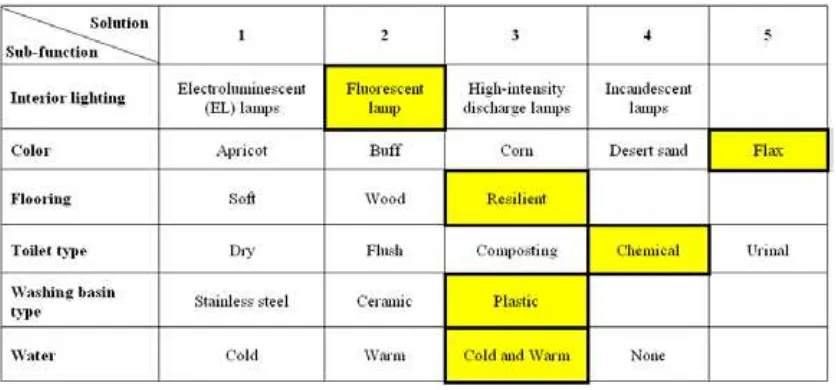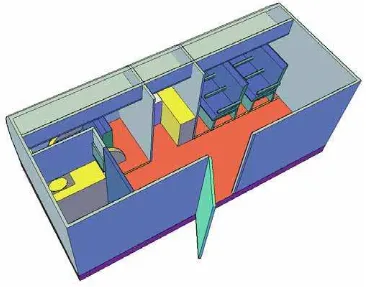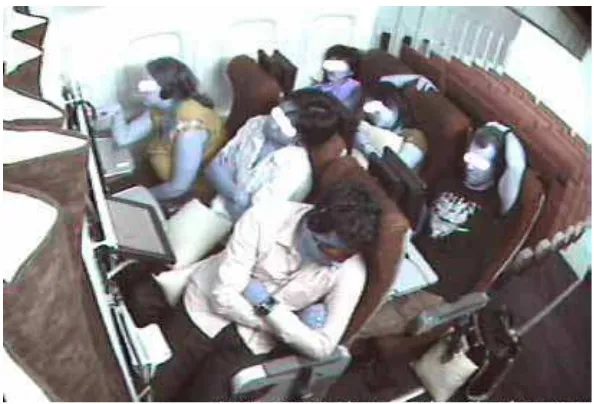INTERNATIONAL DESIGN CONFERENCE - DESIGN 2010 Dubrovnik - Croatia, May 17 - 20, 2010.
TOTAL DESIGN OF LOW COST AIRCRAFT CABIN
SIMULATOR
C. F. Tan,W. Chen and G. W. M. Rauterberg
Keywords: total design, low cost, aircraft cabin, simulator
1. Introduction
Testbed is a platform on which an assortment of experimental tools and products may be deployed and allowed to interact in real-time. Successful tools and products can be identified and developed in an interactive testbed. A testbed also can be defined as an environment that is created for testing and validating purpose. The total design method is the systematic activity oriented, from the market need identification, to the final product that satisfied the need. The activity of total design includes product, process, people and organization [Sapuan 2005].
The aircraft cabin simulator is a testbed that is developed for European project, namely, SEAT (Smart tEchnologies for Stress free Air Travel). The SEAT project aims to develop a new radical approach through integration of cabin systems with multimedia features. The aircraft cabin simulator is fully designed and built by us. The simulator consists of a small scale cabin-like testing platform, an inventory section, a simulation section and a control section. The interior of the aircraft cabin consists of an economy class section, a business class section, a galley and a lavatory. Each passenger seat and the lavatory are provided with a personal entertainment touch screen monitor. An inventory section is used to store the testing related equipments. A sky-like projection environment is created at the external location. In addition, the simulator is built with an innovative low-cost motion platform. The motion platform is used to simulate the flight environment such as taxing, taking off, turbulence, descending and landing. The control section is fully equipped with a state of art computer system that is used to control and monitor the simulator. In this paper, the aircraft cabin simulator was designed with solid modelling software. Five conceptual designs of simulator were developed with 3D solid model. To determine the final design of simulator, the matrix evaluation method was used. The weight of the simulator was obtained through weight analysis. The simulator was successfully designed and built with lower cost compared with the commercial aircraft simulator.
The paper is organized as follows: Section 2 describes the current development of commercial aircraft simulator and Section 3 describes the simulator design methodology. Subsequently, conceptual design of simulator follows in Section 4 and scenario of the final concept presented in Section 5. Section 6 describes the final design of aircraft simulator. The paper is concluded in Section 7.
2. Commercial aircraft simulator
The aircraft cabin simulators have different applications and purposes such as training and research. Czech Airlines equipped with cabin simulator for the Airbus A320 series aircraft. The cabin as shown in Figure 1 is used to train the cabin crews and the pilots; as well as public usage and standard on-board passenger services. The simulator is mounted on a movable base, which allows it to rehearse all routine, as well as non-routine, procedures which take place on board the aircraft in realistic flight conditions. For the motion, the cabin simulator is mounted on a hydraulic base. Some of the cabin Tan, C.F. Chen, W. and Rauterberg, M. “Total design of low cost aircraft cabin simulator”.
windows are equipped with monitors for the visualization of simulated landscapes [Czech Airlines 2009].
Figure 1. The aircraft simulator of Czech Airlines [Czech Airlines 2009]
United Airlines Training Centre is equipped with aircraft simulator for training purpose. The simulator is a fully operational mockup of a Boeing 747 passenger cabin. The cabin trainer and its video system help provide hands-on instruction. United uses the cabin trainer primarily for instruction in food preparation and presentation, passenger safety equipment demos and customer interaction [United Airlines, 2009]. Cranfield University houses two aircraft cabin simulators, the Large Cabin Evacuation Simulator and the Boeing 737 cabin simulator. Both of these simulators are used to conduct research into various aspects of cabin safety. For example, previous research has examined the effectiveness of cabin crew procedures and behavior in emergencies, passenger evacuation rates under various scenarios and conditions, and passenger attention to safety information [Cranfield University 2009]. Figure 2 shows the cabin simulator in Cranfield University.
Figure 2. The aircraft simulator of Cranfield University [Cranfield University 2009]
3. Design methodology of low cost aircraft cabin simulator
Figure 3 shows the design process of aircraft cabin simulator. Market survey is the first process in the design techniques. Various patents, journals, technical report and websites were investigated for related information such as technology and industry analysis. The output of market survey is the product design specifications (PDS).
The PDS was developed as a design guideline for the aircraft simulator. The PDS for the aircraft cabin simulator is shown in Figure 4. The descriptions of the PDS elements as follows:
Performance: the simulator able to work for 10 hours per experiment without failure. The simulator also provides a real flight experience such as motion, sound and temperature for the test subject during the 10 hours experiment.
Materials: The simulator is constructed from a mixture of quality and durable materials such as aluminum, steel, composite material and wood. These materials are selected based on European Standards.
Size:the simulator must be able to fit into provided space in the building. Weight:the weight of the simulator approximately 2000kg.
possible for those areas where a failure could disable or damage equipment and cause injury to personnel.
Safety: Safety is an integral part of all aspects of design. Due consideration should be given to the safety of all personnel whether operating the equipment, maintaining the equipment or installing the equipment.
Standards: The International Standards (ISO), e.g. ISO 9001 would be employed as applicable in the design and build of the simulator. The list of international standards that have been referred as shown in Table 1.
Figure 3. The architecture of the design process of aircraft cabin simulator
Design simplicity: In the interests of production, reliability and maintainability, simplicity of design is a key factor. Features such as modular packaging and a wiring interface which simplifies future expansion or modifications, are standard practices applied within the design review.
Cost: the total cost to build the simulator must be within budget.
Figure 4. The PDS of the development of aircraft cabin simulator
4. Conceptual design of low cost aircraft cabin simulator
After the requirements were determined, the design concept will be generated. The design and development of low cost aircraft cabin simulator encountered different kind of problem which needs to
PDS
Size
Weight
Strength Materials
Performance
Cost
Design simplicity
Safety
be tackled in a stepwise manner. These stages are interrelated and difficult to differentiate. The development of the aircraft simulator employed different methodologies for the concept generation. Some of the methods can be used in the conceptual stage of design. There are many methods available for initiation of concepts. The following are used in this research:
4.1 Creative method
Brainstorming was the creative method that used in the design of simulator. Brainstorming was used to generate as many ideas as possible and as many solutions to each ideas as possible. The brainstorming storming was conducted in a small group session of about four to eight people. The group was encouraged to express various ideas and to defer critical judgment until later. Everyone offer idea that are listed, combined, improved, and changed into various other ideas. The ideas and solutions will be identified and combined to their logical interconnection. In the end, the group agrees on a final resolution and several concepts were generated [Cross 2008].
4.2 The objective tree method
The objective tree method was used to classify the objectives of the simulator in a diagrammatic form. It shows in the form in which different objectives are related to each other, and hierarchical pattern of objectives and sub-objectives. The procedure for arriving at an objectives tree helps to clarify the objectives and to reach agreement between clients and customer [Cross 2008].
4.3 The Performance Specification Method
Design problems are always set within certain limits or constraints. One of the limits of the design of simulator is cost. Other limits were space available and the size of simulator. The performance specification method is intended to help in defining the design problem, leaving the appropriate amount of freedom so that the designer has room to manoeuvre over the ways and means of achieving a satisfactory design solution. The method emphasizes the performance that a design solution has to achieve, and not any particular physical components which may be means of achieving that performance [Cross 2008]. Figure 5 shows the specification of simulator.
4.4 The morphological chart
The morphological chart is a method used to generate design solution in systematically way. It is a method of automatically combining the parameters (characteristic, factor, variable, or aspect) of a challenge into a solution [Pugh 1990]. Cross [2008] described the morphological chart encourages the designer to identify novel combinations of elements. The charts sets out the complete range of elements, components or sub-solutions, which can be combined together to make a solution. The main aim of this method is to widen the search for possible new solutions. Figure 6 shows an example of morphology chart for lavatory section in aircraft cabin simulator. The selection of solution for lavatory was based on the availability and the cost of the component in the market. We try to build a simulator like an average aircraft cabin.
Figure 6. The morphology chart for lavatory section
5. Final concept
In the final concept, five design concepts were generated. All concepts draw in 3D view to visualize and compare the concept clearly. The detail explanations of concepts are as follows:
1. Concept 1: the simulator has economy class area only. There are two rows of economy class seat. The simulator is built on the static platform.
2. Concept 2: the simulator has galley, lavatory and two business class areas. There are two individual business class seats. The simulator is built on the static platform.
3. Concept 3: the simulator has galley, lavatory and two economy class areas. There are two rows of economy class seat. The simulator is built on the static platform.
4. Concept 4: the simulator has galley, lavatory, economy class areas and business class area. There is one row of economy class seat and one row of two person business class seat. The simulator is built on the motion platform.
5. Concept 5: the simulator has galley, lavatory, economy class area and business class area. are two rows of economy class seat and one business class seat. The simulator is built on the motion platform.
6. The computer-aided drawing of concept 5 is showed in Figure 7.
5.1 Concepts Evaluation
The evaluations of the five concepts were carried out by using the weighted objective method. This method provides a means of assessing and comparing alternative designs, using differentially weighted objectives [Sapuan, 2005]. Numerical weights were assigned to objectives and numerical scores to the performances of alternative designs measured against these objectives [Sapuan 2005, Cross 1994, Wright 1998]. The evaluation of five concepts is shown in Table 1. Seven objectives are workable and within the targeted cost, the following objectives were set:
• Functionality • Motion
• Size
• Fit
• Strength
• Environment friendly
Seven objectives have been set to evaluate the concepts. Each objective was provided with relative weight There are considered to have the respective relative weight of 0.25, 0.10, 0.10, 0.15, 0.10, 0.20 and 0.10. During the brainstorming session, each concept is rated with points using ten point scales. Each point is multiplied by the objective weight to give relative values. Each value was summed up to get the total values for each concept. Subsequently, the total values of each concept are compared and the highest values were selected. Concept 5 as shown in Table 1 represented the highest values and selected as best concept.
Figure 7. The computer-aided design of concept 5
6. Final design
The final design of aircraft simulator was designed and tested with CAD/CAM system. The aircraft simulator included an economy class section (with two rows 3 person economy class seat), a business class section (with a business class seat), a galley and a lavatory. The simulator was built with wood and medium density fibre board material. There are eight touch screen in-flight entertainment system for each passenger as well as inside the lavatory. The foundation was enhanced to withstand the dynamic impact that caused by the motion action.
The business class section is equipped with a massage chair, a touch screen monitor, a high quality surround sound system and a 47 inches ambient LCD television. Two rows of economy class seat were setup; each of the seats was equipped with a touch screen monitor and a noise reduction ear phone. The seat was embedded by a series of sensors to detect the physiological and posture change of the passenger. Figure 8 shows the snap shoot of economy class section during 10 hours experiment.
Figure 8. Economy class section in action
7. Conclusion
The aircraft cabin simulator was designed with the systematic total design approach. The systematic design approach is able to guide the designer to achieve the final goals. The total design was useful for the development of aircraft cabin simulator from concept to real build-up. The market survey, design knowledge and design experience were important at first stage of project. PDS provided the designer a way to keep track and refer with the specification. The morphological chart helped the designer to identify the various design solutions and product functions in a systematic way. The weighted objective method was used in the brainstorming and mind mapping session to generate and determine the final concept. Various design methods were extensively used and it was proved to be a useful tool in the development of aircraft cabin simulator. The design and development of low cost aircraft cabin simulator can be seen as valuable contribution to small and medium scale research institution and design house that focus on aviation industry research and development.
Acknowledgement
References
Cranfield University, Aircraft cabin simulator. http://www.cranfield.ac.uk/ soe/ facilities/ page5263. jsp. Accessed on 1 August 2009.
Cross, N., “Engineering Design Methods: Strategies for Product Design”, Wiley & Sons Ltd., Chichester, 2008. Czech Airlines, New czech airlines cabin simulator about to become available for the public "Flying without Fear" Courses. http://www.csanews.cz/en/news/ news_tzarchiv_data/tz_13122007A/ tz_13122007A_pdf. Accessed on 25 August 2009.
Pugh, S., “Total Design – Integrated Methods for Successful Product Engineering”, Addison Wesley Publishing, UK, 1990.
Sapuan, S. M., “A Conceptual Design of the Concurrent Engineering Design System for Polymeric-based Composite Automotive Pedals”, Americal Journal of Applied Sciences, Vol. 2, No. 2, 2005, pp 514-525.
United Airlines, Aircraft simulator at heart of united airlines training efforts. http://www.unitedvisual.com/2train/ 2tr104.asp. Accessed on 8 August 2009.
Wright, I., “Design Methods in Engineering and Product Design”, McGraw-Hill International Limited, 1998.
CheeFai Tan PhD student
Eindhoven University of Technology, Designed Intelligence Group Den Dolech 2, Eindhoven, the Netherlands
Telephone: +31-40 247 2514 Email: c.f.tan@tue.nl
Universiti Teknikal Malaysia Melaka Melaka, Malaysia
![Figure 1. The aircraft simulator of Czech Airlines [Czech Airlines 2009]](https://thumb-ap.123doks.com/thumbv2/123dok/620425.74734/2.595.207.390.103.225/figure-aircraft-simulator-czech-airlines-czech-airlines.webp)
